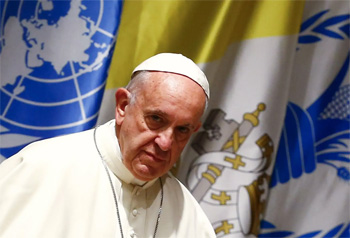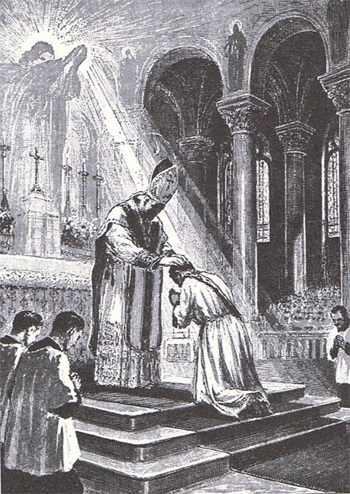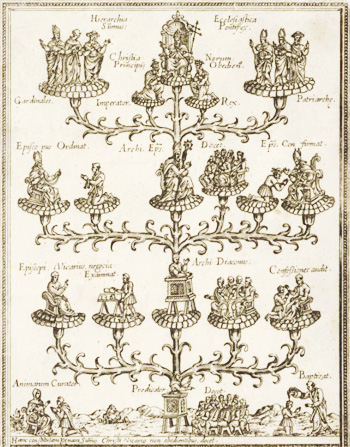Asuntos Tradicionalistas
 |
 |
 |
 |
 |
 |
 |
Misa de Diálogo - CXXVI
Rehacer la Iglesia a
la imagen y semejanza del mundo
Ya hemos visto cómo la estructura monárquica de la Constitución de la Iglesia fue derrocada en el Concilio Vaticano II.
El Padre Tyrrell encabezó la revolución y el Papa Francisco fue fundamental para llevarla a buen término. Un componente clave de su trabajo fue socavar la supremacía papal y su reemplazo por un sistema democrático de poder compartido.
Francisco, por supuesto, continúa el trabajo de los primeros modernistas y sus predecesores conciliares al desinflar la estatura del Papado a un nivel democrático; afirmó, por ejemplo, que está “en la Iglesia como bautizado” entre los bautizados, y “en el Colegio Episcopal como Obispo entre Obispos”. (1) También reclama nada más que “una primacía de honor para el obispo de Roma”. (¿Cuántos saben hoy que esta designación fue favorecida por el padre Tyrrell?) Sin embargo, es solo un título de cortesía y se entiende comúnmente como el "primero entre iguales", como el que disfrutan los líderes políticos en un país democrático. Se aplica, por ejemplo, al primer ministro británico, que es líder de un gabinete en lugar de ocupar un cargo superior al de sus ministros. Esta redefinición del Ministerio Petrino ha sido aceptada durante mucho tiempo por protestantes y cismáticos. Pero cualquier mención de la doctrina católica de la supremacía papal levanta inmediatamente los pelos de punta como un obstáculo para el “diálogo” ecuménico.
 Tanto Tyrrell como Francis están de acuerdo en pensar que para que la Iglesia se convierta en una sociedad democrática, debe ser descentralizada, con el poder ejecutivo otorgado al pueblo.
El Padre Tyrrell declaró:
Tanto Tyrrell como Francis están de acuerdo en pensar que para que la Iglesia se convierta en una sociedad democrática, debe ser descentralizada, con el poder ejecutivo otorgado al pueblo.
El Padre Tyrrell declaró:
“La cooperación activa y la responsabilidad por la vida corporativa son lo que constituye la personalidad y la ciudadanía. De tal responsabilidad y cooperación, los laicos, luego el bajo clero, finalmente los mismos obispos, han sido privados por un sistema de centralización. Eso deja al Papa como la única personalidad responsable en la Iglesia, o más bien, fuera y por encima de ella. El fruto es esa completa decadencia del interés en el bienestar del cuerpo por parte de sus miembros pasivos e irresponsables.” (2)
Los reformadores progresistas denuncian la “pasividad” de los laicos y exigen la participación de todos los fieles en la misión de la Iglesia, como consecuencia de la enseñanza neomodernista del Vaticano II. Posteriormente, los Papas Conciliares, que tienen el deber moral de defender la Tradición y mostrar a los neomodernistas que sus herejías serán combatidas y derrotadas, han estado apaciguando a las turbas anticlericalistas.
Tyrrell y Francisco degradan el sacerdocio
Aquí la influencia del P. Tyrrell es primordial:
“El abuso conocido como “sacerdotalismo” surge de la atribución a los funcionarios de una cierta superioridad espiritual meramente en virtud de su oficio, como si el valor de los actos que realizan, meramente en nombre y por el poder de toda la Iglesia, derivara de alguna cualidad inherente de sus almas que los eleva por encima de los laicos en dignidad espiritual”. (3)
Este tipo de pensamiento ha tenido un gran impacto en la actual crisis de identidad del sacerdocio católico desde el Vaticano II, y es en gran parte el resultado de la negación progresista de un “carácter” fundamental impreso en el alma de un sacerdote en su ordenación. Abundan las pruebas que demuestran que esta comprensión de la identidad sacerdotal ya no se reconoce en general que el padere Tyrrell y todos los modernistas se negaron a creer que el efecto del Sacramento de la Ordenación, es decir, configurar al sacerdote con Cristo, Cabeza de la Iglesia, ipso facto lo eleva en dignidad espiritual por encima de los laicos. En Evangelii gaudium, el Papa Francisco se unió al coro de la negación modernista:
“La configuración del sacerdote con Cristo cabeza, es decir, como fuente principal de la gracia, no implica una exaltación que lo sitúe por encima de los demás. En la Iglesia, las funciones no favorecen la superioridad de unos frente a otros”. (4)
 El error fundamental en este pasaje radica en no reconocer la naturaleza sobrenatural del sacerdocio, y en reducirlo a un nivel meramente humano y funcional, como representando un papel, y enfáticamente no superior, entre muchos en la Iglesia.
El error fundamental en este pasaje radica en no reconocer la naturaleza sobrenatural del sacerdocio, y en reducirlo a un nivel meramente humano y funcional, como representando un papel, y enfáticamente no superior, entre muchos en la Iglesia.
Este fue exactamente el enfoque de Tyrrell, y Francisco lo respaldó en el mismo párrafo:
“El sacerdocio ministerial es [solo] uno de los medios empleados por Jesús para el servicio de su pueblo, pero nuestra gran dignidad deriva del bautismo, que es accesible a todos”.
De manera reveladora, no se hace mención de la dignidad infinitamente mayor del sacerdote que proviene del poder que ha recibido en el Sacramento de la Ordenación para efectuar la Transubstanciación, así como su poder para perdonar los pecados.
En el nuevo paradigma del sacerdocio, el estatus único del sacerdote como representante de Cristo Sumo Sacerdote se equipara a los múltiples “ministerios” desempeñados por los laicos. Así es como el sacerdocio ministerial desde el Concilio Vaticano II ha sido marginado como no merecedor de especial reverencia y engullido dentro de una genérica “gran dignidad” atribuida a todos los bautizados.
Francisco retoma el mismo tema que Tyrrell:
“En virtud de su Bautismo, todos los miembros del Pueblo de Dios se han convertido en discípulos misioneros (cf. Mt 28, 19). Todos los bautizados, cualquiera que sea su posición en la Iglesia o su nivel de instrucción en la Fe, son agentes de evangelización, y sería insuficiente prever un plan de evangelización realizado por profesionales mientras que el resto de los fieles sería simplemente destinatarios pasivos”. (5)
Francisco expresó alto y claro su opinión de que a los laicos se les ha negado el acceso a los cargos ejecutivos en la Iglesia porque “no se les ha dado espacio para hablar y actuar, debido a un clericalismo excesivo que los aleja de la toma de decisiones”. (6)
Este es un ataque obvio a la tradición bimilenaria de la Iglesia, prescrita en el Código de Derecho Canónico de 1917, de que los cargos eclesiásticos y el poder de gobierno estaban reservados “solo a los clérigos”. (Canon 118)
 Como resultado del rechazo del Concilio Vaticano II a esta tradición que, ahora se cree, es una injusticia para los derechos de los laicos, la visión del padre Tyrrell de la Iglesia como “un organismo autodidacta y autónomo” (7) se está realizando ante nuestros ojos. El Papa Francisco retoma el mismo tema, invirtiéndolo con una narrativa cargada de emociones sobre la victimización laica a manos de un clero explotador:
Como resultado del rechazo del Concilio Vaticano II a esta tradición que, ahora se cree, es una injusticia para los derechos de los laicos, la visión del padre Tyrrell de la Iglesia como “un organismo autodidacta y autónomo” (7) se está realizando ante nuestros ojos. El Papa Francisco retoma el mismo tema, invirtiéndolo con una narrativa cargada de emociones sobre la victimización laica a manos de un clero explotador:
“Hay ese espíritu de clericalismo en la Iglesia, que sentimos: los clérigos se sienten superiores; los clérigos se distancian del pueblo. Los clérigos siempre dicen: 'esto hay que hacerlo así, así, así, y tú ¡vete!', sucede cuando el clérigo no tiene tiempo de escuchar a los que sufren, a los pobres, a los enfermos, a los encarcelados: el mal del clericalismo es una cosa realmente horrible; es una nueva edición de este antiguo mal [de las autoridades religiosas enseñoreándose de los demás]. Pero la víctima es la misma: el pueblo pobre y humilde, que espera al Señor”. (8)
Es evidentemente obvio por el tenor de inspiración marxista de esta caricatura anticlerical que Francisco está socavando los cimientos de su propio papado, que se basa en la autoridad que ha recibido para gobernar la Iglesia.
Continuará ...

Francisco, por supuesto, continúa el trabajo de los primeros modernistas y sus predecesores conciliares al desinflar la estatura del Papado a un nivel democrático; afirmó, por ejemplo, que está “en la Iglesia como bautizado” entre los bautizados, y “en el Colegio Episcopal como Obispo entre Obispos”. (1) También reclama nada más que “una primacía de honor para el obispo de Roma”. (¿Cuántos saben hoy que esta designación fue favorecida por el padre Tyrrell?) Sin embargo, es solo un título de cortesía y se entiende comúnmente como el "primero entre iguales", como el que disfrutan los líderes políticos en un país democrático. Se aplica, por ejemplo, al primer ministro británico, que es líder de un gabinete en lugar de ocupar un cargo superior al de sus ministros. Esta redefinición del Ministerio Petrino ha sido aceptada durante mucho tiempo por protestantes y cismáticos. Pero cualquier mención de la doctrina católica de la supremacía papal levanta inmediatamente los pelos de punta como un obstáculo para el “diálogo” ecuménico.

El Papa de la democracia
“La cooperación activa y la responsabilidad por la vida corporativa son lo que constituye la personalidad y la ciudadanía. De tal responsabilidad y cooperación, los laicos, luego el bajo clero, finalmente los mismos obispos, han sido privados por un sistema de centralización. Eso deja al Papa como la única personalidad responsable en la Iglesia, o más bien, fuera y por encima de ella. El fruto es esa completa decadencia del interés en el bienestar del cuerpo por parte de sus miembros pasivos e irresponsables.” (2)
Los reformadores progresistas denuncian la “pasividad” de los laicos y exigen la participación de todos los fieles en la misión de la Iglesia, como consecuencia de la enseñanza neomodernista del Vaticano II. Posteriormente, los Papas Conciliares, que tienen el deber moral de defender la Tradición y mostrar a los neomodernistas que sus herejías serán combatidas y derrotadas, han estado apaciguando a las turbas anticlericalistas.
Tyrrell y Francisco degradan el sacerdocio
Aquí la influencia del P. Tyrrell es primordial:
“El abuso conocido como “sacerdotalismo” surge de la atribución a los funcionarios de una cierta superioridad espiritual meramente en virtud de su oficio, como si el valor de los actos que realizan, meramente en nombre y por el poder de toda la Iglesia, derivara de alguna cualidad inherente de sus almas que los eleva por encima de los laicos en dignidad espiritual”. (3)
Este tipo de pensamiento ha tenido un gran impacto en la actual crisis de identidad del sacerdocio católico desde el Vaticano II, y es en gran parte el resultado de la negación progresista de un “carácter” fundamental impreso en el alma de un sacerdote en su ordenación. Abundan las pruebas que demuestran que esta comprensión de la identidad sacerdotal ya no se reconoce en general que el padere Tyrrell y todos los modernistas se negaron a creer que el efecto del Sacramento de la Ordenación, es decir, configurar al sacerdote con Cristo, Cabeza de la Iglesia, ipso facto lo eleva en dignidad espiritual por encima de los laicos. En Evangelii gaudium, el Papa Francisco se unió al coro de la negación modernista:
“La configuración del sacerdote con Cristo cabeza, es decir, como fuente principal de la gracia, no implica una exaltación que lo sitúe por encima de los demás. En la Iglesia, las funciones no favorecen la superioridad de unos frente a otros”. (4)

El sacerdote es sagrado y divinamente ordenado
Este fue exactamente el enfoque de Tyrrell, y Francisco lo respaldó en el mismo párrafo:
“El sacerdocio ministerial es [solo] uno de los medios empleados por Jesús para el servicio de su pueblo, pero nuestra gran dignidad deriva del bautismo, que es accesible a todos”.
De manera reveladora, no se hace mención de la dignidad infinitamente mayor del sacerdote que proviene del poder que ha recibido en el Sacramento de la Ordenación para efectuar la Transubstanciación, así como su poder para perdonar los pecados.
En el nuevo paradigma del sacerdocio, el estatus único del sacerdote como representante de Cristo Sumo Sacerdote se equipara a los múltiples “ministerios” desempeñados por los laicos. Así es como el sacerdocio ministerial desde el Concilio Vaticano II ha sido marginado como no merecedor de especial reverencia y engullido dentro de una genérica “gran dignidad” atribuida a todos los bautizados.
Francisco retoma el mismo tema que Tyrrell:
“En virtud de su Bautismo, todos los miembros del Pueblo de Dios se han convertido en discípulos misioneros (cf. Mt 28, 19). Todos los bautizados, cualquiera que sea su posición en la Iglesia o su nivel de instrucción en la Fe, son agentes de evangelización, y sería insuficiente prever un plan de evangelización realizado por profesionales mientras que el resto de los fieles sería simplemente destinatarios pasivos”. (5)
Francisco expresó alto y claro su opinión de que a los laicos se les ha negado el acceso a los cargos ejecutivos en la Iglesia porque “no se les ha dado espacio para hablar y actuar, debido a un clericalismo excesivo que los aleja de la toma de decisiones”. (6)
Este es un ataque obvio a la tradición bimilenaria de la Iglesia, prescrita en el Código de Derecho Canónico de 1917, de que los cargos eclesiásticos y el poder de gobierno estaban reservados “solo a los clérigos”. (Canon 118)

Una jerarquía que se remonta a miles de años
“Hay ese espíritu de clericalismo en la Iglesia, que sentimos: los clérigos se sienten superiores; los clérigos se distancian del pueblo. Los clérigos siempre dicen: 'esto hay que hacerlo así, así, así, y tú ¡vete!', sucede cuando el clérigo no tiene tiempo de escuchar a los que sufren, a los pobres, a los enfermos, a los encarcelados: el mal del clericalismo es una cosa realmente horrible; es una nueva edición de este antiguo mal [de las autoridades religiosas enseñoreándose de los demás]. Pero la víctima es la misma: el pueblo pobre y humilde, que espera al Señor”. (8)
Es evidentemente obvio por el tenor de inspiración marxista de esta caricatura anticlerical que Francisco está socavando los cimientos de su propio papado, que se basa en la autoridad que ha recibido para gobernar la Iglesia.
Continuará ...
- Francisco, Discurso en la Conmemoración del 50 Aniversario de la Institución del Sínodo de los Obispos, 17 de octubre de 2015.
- G. Tyrrell, Medievalismo, p. 102.
- Tyrrell, La Iglesia y el futuro, págs. 133-134.
- Francisco, Evangelii gaudium, 2013, § 104.
- Ibíd., § 120
- Ibíd., § 102.
- G. Tyrrell, “Lord Halifax Demurs”, The Weekly Register, n. 2680, 3 de mayo de 1901, pág. 550, apud David Wells, La teología profética de George Tyrrell, Chico, CA: Scholars Press, 1979, p. 49.
- Francisco, “Gente descartada”, Homilía en Casa Santa María, 13 de diciembre de 2016.
Publicado el 10 de mayo de 2023

______________________
______________________
 Volume I |
 Volume II |
 Volume III |
 Volume IV |
 Volume V |
 Volume VI |
 Volume VII |
 Volume VIII |
 Volume IX |
 Volume X |
 Volume XI |
 Special Edition |






